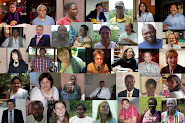 Blog Action Day 2008 focused on poverty. Nearly 13,000 blogs responded with an outpouring of posts on October 15. CCL's Leading Effectively blog featured two contributions:
Blog Action Day 2008 focused on poverty. Nearly 13,000 blogs responded with an outpouring of posts on October 15. CCL's Leading Effectively blog featured two contributions: In Reflections on Poverty, Talula Cartwright traces her family’s history and recalls when hardship was deeply woven into the fabric of America:
"Some of my ancestors had been potato farmers from Ireland. They lived in holes they dug out of the hills. When the potato blight came, they starved. The ones who were lucky came to America on ships. A lot of them died. Some of my other ancestors were Choctaw Indians. When the U.S. Government computed the poverty index sometime back, they said it was anything below two-thousand-something for a family of four. At that time, the average income for a Choctaw family was less than $700 a year. And it was for way more than four people. The Choctaws were very poor people. But they were one of the five civilized tribes. (That means they didn’t fight back.) So back in the eighteen-hundreds, when the Irish were starving, the Choctaws sent them some money! A hundred dollars or so. An enormous amount of money at the time. I have a painting on my wall that commemorates this. The Irish hired a Choctaw to paint it, for their anniversary. The poor, honoring the poor."
In Tragedy of the Commons, David Altman wrote about rethinking individual wellbeing in the wake of the global financial crisis:
"...we could travel down a path leading to a Tragedy of the Commons or we could take a seemingly more circuitous route down an alley called the Prosperity of the Commons. The tragedy path brings with it short-term feelings of happiness (perhaps like a cocaine-high). The prosperity route comes with much pain and sacrifice but will ultimately bring benefits that are nearly impossible to see in the short-term."
These posts speak to the value of interdependence and mutual concern in the face of hard times. They also bring to mind lessons from another recent crisis.
During Hurricane Katrina one of most generous demonstrations of caring came from the people of Ville Platte, Louisiana, one of America's poorest communities. The town rallied together to welcome and care for some 10,000 evacuees fleeing the storm (more on this story). This act of collective kindness is an important statement in our age of affluence and inequity . It is often the poor who can teach us best about generosity, community, and collective leadership.

 Preston Yarborough
Preston Yarborough

















